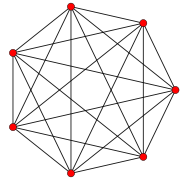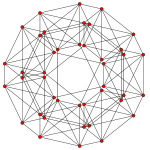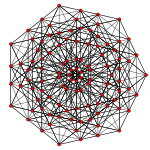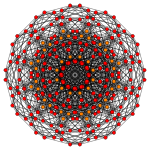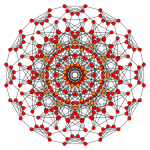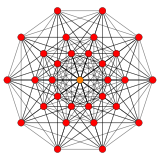Uniform 6-polytope
In six-dimensional geometry, a uniform polypeton[1][2] (or uniform 6-polytope) is a six-dimensional uniform polytope. A uniform polypeton is vertex-transitive, and all facets are uniform 5-polytopes.
The complete set of convex uniform polypeta has not been determined, but most can be made as Wythoff constructions from a small set of symmetry groups. These construction operations are represented by the permutations of rings of the Coxeter-Dynkin diagrams. Each combination of at least one ring on every connected group of nodes in the diagram produces a uniform 6-polytope.
The simplest uniform polypeta are regular polytopes: the 6-simplex {3,3,3,3,3}, the 6-cube (hexeract) {4,3,3,3,3}, and the 6-orthoplex (hexacross) {3,3,3,3,4}.
History of discovery
- Regular polytopes: (convex faces)
- 1852: Ludwig Schläfli proved in his manuscript Theorie der vielfachen Kontinuität that there are exactly 3 regular polytopes in 5 or more dimensions.
- Convex semiregular polytopes: (Various definitions before Coxeter's uniform category)
- 1900: Thorold Gosset enumerated the list of nonprismatic semiregular convex polytopes with regular facets (convex regular polytera) in his publication On the Regular and Semi-Regular Figures in Space of n Dimensions.[3]
- Convex uniform polytopes:
- 1940: The search was expanded systematically by H.S.M. Coxeter in his publication Regular and Semi-Regular Polytopes.
- Nonregular uniform star polytopes: (similar to the nonconvex uniform polyhedra)
- Ongoing: Thousands of nonconvex uniform polypeta are known, but mostly unpublished. The list is presumed not to be complete, and there is no estimate of how long the complete list will be, although over 10000 convex and nonconvex uniform polytera are currently known, in particular 923 with 6-simplex symmetry. Participating researchers include Jonathan Bowers, Richard Klitzing and Norman Johnson.[4]
Uniform 6-polytopes by fundamental Coxeter groups
Uniform 6-polytopes with reflective symmetry can be generated by these four Coxeter groups, represented by permutations of rings of the Coxeter-Dynkin diagrams.
There are four fundamental reflective symmety groups which generate 153 unique uniform 6-polytopes.
| # | Coxeter group | Coxeter-Dynkin diagram | |
|---|---|---|---|
| 1 | A6 | [3,3,3,3,3] | |
| 2 | B6 | [3,3,3,3,4] | |
| 3 | D6 | [3,3,3,31,1] | |
| 4 | E6 | [32,2,1] | |
| [3,32,2] | |||
 Coxeter-Dynkin diagram correspondences between families and higher symmetry within diagrams. Nodes of the same color in each row represent identical mirrors. Black nodes are not active in the correspondence. |
Uniform prismatic families
Uniform prism
There are 6 categorical uniform prisms based on the uniform 5-polytopes.
| # | Coxeter group | Notes | ||
|---|---|---|---|---|
| 1 | A5A1 | [3,3,3,3,2] | Prism family based on 5-simplex | |
| 2 | B5A1 | [4,3,3,3,2] | Prism family based on 5-cube | |
| 3a | D5A1 | [32,1,1,2] | Prism family based on 5-demicube | |
| # | Coxeter group | Notes | ||
|---|---|---|---|---|
| 4 | A3I2(p)A1 | [3,3,2,p,2] | Prism family based on tetrahedral-p-gonal duoprisms | |
| 5 | B3I2(p)A1 | [4,3,2,p,2] | Prism family based on cubic-p-gonal duoprisms | |
| 6 | H3I2(p)A1 | [5,3,2,p,2] | Prism family based on dodecahedral-p-gonal duoprisms | |
Uniform duoprism
There are 11 categorical uniform duoprismatic families of polytopes based on Cartesian products of lower-dimensional uniform polytopes. Five are formed as the product of a uniform 4-polytope with a regular polygon, and six are formed by the product of two uniform polyhedra:
| # | Coxeter group | Notes | ||
|---|---|---|---|---|
| 1 | A4I2(p) | [3,3,3,2,p] | Family based on 5-cell-p-gonal duoprisms. | |
| 2 | B4I2(p) | [4,3,3,2,p] | Family based on tesseract-p-gonal duoprisms. | |
| 3 | F4I2(p) | [3,4,3,2,p] | Family based on 24-cell-p-gonal duoprisms. | |
| 4 | H4I2(p) | [5,3,3,2,p] | Family based on 120-cell-p-gonal duoprisms. | |
| 5 | D4I2(p) | [31,1,1,2,p] | Family based on demitesseract-p-gonal duoprisms. | |
| # | Coxeter group | Notes | ||
|---|---|---|---|---|
| 6 | A32 | [3,3,2,3,3] | Family based on tetrahedral duoprisms. | |
| 7 | A3B3 | [3,3,2,4,3] | Family based on tetrahedral-cubic duoprisms. | |
| 8 | A3H3 | [3,3,2,5,3] | Family based on tetrahedral-dodecahedral duoprisms. | |
| 9 | B32 | [4,3,2,4,3] | Family based on cubic duoprisms. | |
| 10 | B3H3 | [4,3,2,5,3] | Family based on cubic-dodecahedral duoprisms. | |
| 11 | H32 | [5,3,2,5,3] | Family based on dodecahedral duoprisms. | |
Uniform triaprism
There is one infinite family of uniform triaprismatic families of polytopes constructed as a Cartesian products of three regular polygons. Each combination of at least one ring on every connected group produces a uniform prismatic 6-polytope.
| # | Coxeter group | Notes | ||
|---|---|---|---|---|
| 1 | I2(p)I2(q)I2(r) | [p,2,q,2,r] | Family based on p,q,r-gonal triprisms | |
Enumerating the convex uniform 6-polytopes
- Simplex family: A6 [34] -











- 35 uniform 6-polytopes as permutations of rings in the group diagram, including one regular:
- {34} - 6-simplex -











- {34} - 6-simplex -
- 35 uniform 6-polytopes as permutations of rings in the group diagram, including one regular:
- Hypercube/orthoplex family: B6 [4,34] -











- 63 uniform 6-polytopes as permutations of rings in the group diagram, including two regular forms:
- {4,33} — 6-cube (hexeract) -











- {33,4} — 6-orthoplex, (hexacross) -











- {4,33} — 6-cube (hexeract) -
- 63 uniform 6-polytopes as permutations of rings in the group diagram, including two regular forms:
- Demihypercube D6 family: [33,1,1] -









- 47 uniform 6-polytopes (16 unique) as permutations of rings in the group diagram, including:
- {3,32,1}, 121 6-demicube (demihexeract) -








 ; also as h{4,33},
; also as h{4,33}, 










- {3,3,31,1}, 211 6-orthoplex -









- {3,32,1}, 121 6-demicube (demihexeract) -
- 47 uniform 6-polytopes (16 unique) as permutations of rings in the group diagram, including:
- E6 family: [33,1,1] -









These fundamental families generate 153 nonprismatic convex uniform polypeta.
In addition, there are 105 uniform 6-polytope constructions based on prisms of the uniform 5-polytopes: [3,3,3,3,2], [4,3,3,3,2], [5,3,3,3,2], [32,1,1,2].
In addition, there are infinitely many uniform 6-polytope based on:
- Duoprism prism families: [3,3,2,p,2], [4,3,2,p,2], [5,3,2,p,2].
- Duoprism families: [3,3,3,2,p], [4,3,3,2,p], [5,3,3,2,p].
- Triaprism family: [p,2,q,2,r].
The A6 family
There are 32+4−1=35 forms, derived by marking one or more nodes of the Coxeter-Dynkin diagram. All 35 are enumerated below. They are named by Norman Johnson from the Wythoff construction operations upon regular 6-simplex (heptapeton). Bowers-style acronym names are given in parentheses for cross-referencing.
The A6 family has symmetry of order 5040 (7 factorial).
The coordinates of uniform 6-polytopes with 6-simplex symmetry can be generated as permutations of simple integers in 7-space, all in hyperplanes with normal vector (1,1,1,1,1,1,1).
See also list of A6 polytopes for graphs of these polytopes.
| # | Coxeter-Dynkin | Johnson naming system Bowers name and (acronym) |
Base point | Element counts | |||||
|---|---|---|---|---|---|---|---|---|---|
| 5 | 4 | 3 | 2 | 1 | 0 | ||||
| 1 | 6-simplex heptapeton (hop) |
(0,0,0,0,0,0,1) | 7 | 21 | 35 | 35 | 21 | 7 | |
| 2 | Rectified 6-simplex rectified heptapeton (ril) |
(0,0,0,0,0,1,1) | 14 | 63 | 140 | 175 | 105 | 21 | |
| 3 | Truncated 6-simplex truncated heptapeton (til) |
(0,0,0,0,0,1,2) | 14 | 63 | 140 | 175 | 126 | 42 | |
| 4 | Birectified 6-simplex birectified heptapeton (bril) |
(0,0,0,0,1,1,1) | 14 | 84 | 245 | 350 | 210 | 35 | |
| 5 | Cantellated 6-simplex small rhombated heptapeton (sril) |
(0,0,0,0,1,1,2) | 35 | 210 | 560 | 805 | 525 | 105 | |
| 6 | Bitruncated 6-simplex bitruncated heptapeton (batal) |
(0,0,0,0,1,2,2) | 14 | 84 | 245 | 385 | 315 | 105 | |
| 7 | Cantitruncated 6-simplex great rhombated heptapeton (gril) |
(0,0,0,0,1,2,3) | 35 | 210 | 560 | 805 | 630 | 210 | |
| 8 | Runcinated 6-simplex small prismated heptapeton (spil) |
(0,0,0,1,1,1,2) | 70 | 455 | 1330 | 1610 | 840 | 140 | |
| 9 | Bicantellated 6-simplex small prismated heptapeton (sabril) |
(0,0,0,1,1,2,2) | 70 | 455 | 1295 | 1610 | 840 | 140 | |
| 10 | Runcitruncated 6-simplex prismatotruncated heptapeton (patal) |
(0,0,0,1,1,2,3) | 70 | 560 | 1820 | 2800 | 1890 | 420 | |
| 11 | Tritruncated 6-simplex tetradecapeton (fe) |
(0,0,0,1,2,2,2) | 14 | 84 | 280 | 490 | 420 | 140 | |
| 12 | Runcicantellated 6-simplex prismatorhombated heptapeton (pril) |
(0,0,0,1,2,2,3) | 70 | 455 | 1295 | 1960 | 1470 | 420 | |
| 13 | Bicantitruncated 6-simplex great birhombated heptapeton (gabril) |
(0,0,0,1,2,3,3) | 49 | 329 | 980 | 1540 | 1260 | 420 | |
| 14 | Runcicantitruncated 6-simplex great prismated heptapeton (gapil) |
(0,0,0,1,2,3,4) | 70 | 560 | 1820 | 3010 | 2520 | 840 | |
| 15 | Stericated 6-simplex small cellated heptapeton (scal) |
(0,0,1,1,1,1,2) | 105 | 700 | 1470 | 1400 | 630 | 105 | |
| 16 | Biruncinated 6-simplex small biprismato-tetradecapeton (sibpof) |
(0,0,1,1,1,2,2) | 84 | 714 | 2100 | 2520 | 1260 | 210 | |
| 17 | Steritruncated 6-simplex cellitruncated heptapeton (catal) |
(0,0,1,1,1,2,3) | 105 | 945 | 2940 | 3780 | 2100 | 420 | |
| 18 | Stericantellated 6-simplex cellirhombated heptapeton (cral) |
(0,0,1,1,2,2,3) | 105 | 1050 | 3465 | 5040 | 3150 | 630 | |
| 19 | Biruncitruncated 6-simplex biprismatorhombated heptapeton (bapril) |
(0,0,1,1,2,3,3) | 84 | 714 | 2310 | 3570 | 2520 | 630 | |
| 20 | Stericantitruncated 6-simplex celligreatorhombated heptapeton (cagral) |
(0,0,1,1,2,3,4) | 105 | 1155 | 4410 | 7140 | 5040 | 1260 | |
| 21 | Steriruncinated 6-simplex celliprismated heptapeton (copal) |
(0,0,1,2,2,2,3) | 105 | 700 | 1995 | 2660 | 1680 | 420 | |
| 22 | Steriruncitruncated 6-simplex celliprismatotruncated heptapeton (captal) |
(0,0,1,2,2,3,4) | 105 | 945 | 3360 | 5670 | 4410 | 1260 | |
| 23 | Steriruncicantellated 6-simplex celliprismatorhombated heptapeton (copril) |
(0,0,1,2,3,3,4) | 105 | 1050 | 3675 | 5880 | 4410 | 1260 | |
| 24 | Biruncicantitruncated 6-simplex great biprismato-tetradecapeton (gibpof) |
(0,0,1,2,3,4,4) | 84 | 714 | 2520 | 4410 | 3780 | 1260 | |
| 25 | Steriruncicantitruncated 6-simplex great cellated heptapeton (gacal) |
(0,0,1,2,3,4,5) | 105 | 1155 | 4620 | 8610 | 7560 | 2520 | |
| 26 | Pentellated 6-simplex small teri-tetradecapeton (staff) |
(0,1,1,1,1,1,2) | 126 | 434 | 630 | 490 | 210 | 42 | |
| 27 | Pentitruncated 6-simplex teracellated heptapeton (tocal) |
(0,1,1,1,1,2,3) | 126 | 826 | 1785 | 1820 | 945 | 210 | |
| 28 | Penticantellated 6-simplex teriprismated heptapeton (topal) |
(0,1,1,1,2,2,3) | 126 | 1246 | 3570 | 4340 | 2310 | 420 | |
| 29 | Penticantitruncated 6-simplex terigreatorhombated heptapeton (togral) |
(0,1,1,1,2,3,4) | 126 | 1351 | 4095 | 5390 | 3360 | 840 | |
| 30 | Pentiruncitruncated 6-simplex tericellirhombated heptapeton (tocral) |
(0,1,1,2,2,3,4) | 126 | 1491 | 5565 | 8610 | 5670 | 1260 | |
| 31 | Pentiruncicantellated 6-simplex teriprismatorhombi-tetradecapeton (taporf) |
(0,1,1,2,3,3,4) | 126 | 1596 | 5250 | 7560 | 5040 | 1260 | |
| 32 | Pentiruncicantitruncated 6-simplex terigreatoprismated heptapeton (tagopal) |
(0,1,1,2,3,4,5) | 126 | 1701 | 6825 | 11550 | 8820 | 2520 | |
| 33 | Pentisteritruncated 6-simplex tericellitrunki-tetradecapeton (tactaf) |
(0,1,2,2,2,3,4) | 126 | 1176 | 3780 | 5250 | 3360 | 840 | |
| 34 | Pentistericantitruncated 6-simplex tericelligreatorhombated heptapeton (tacogral) |
(0,1,2,2,3,4,5) | 126 | 1596 | 6510 | 11340 | 8820 | 2520 | |
| 35 | Omnitruncated 6-simplex great teri-tetradecapeton (gotaf) |
(0,1,2,3,4,5,6) | 126 | 1806 | 8400 | 16800 | 15120 | 5040 | |
The B6 family
There are 63 forms based on all permutations of the Coxeter-Dynkin diagrams with one or more rings.
The B6 family has symmetry of order 46080 (6 factorial x 26).
They are named by Norman Johnson from the Wythoff construction operations upon the regular 6-cube and 6-orthoplex. Bowers names and acronym names are given for cross-referencing.
See also list of B6 polytopes for graphs of these polytopes.
| # | Coxeter-Dynkin diagram | Schläfli symbol | Names | Element counts | |||||
|---|---|---|---|---|---|---|---|---|---|
| 5 | 4 | 3 | 2 | 1 | 0 | ||||
| 36 | t0{3,3,3,3,4} | 6-orthoplex Hexacontatetrapeton (gee) | 64 | 192 | 240 | 160 | 60 | 12 | |
| 37 | t1{3,3,3,3,4} | Rectified 6-orthoplex Rectified hexacontatetrapeton (rag) | 76 | 576 | 1200 | 1120 | 480 | 60 | |
| 38 | t2{3,3,3,3,4} | Birectified 6-orthoplex Birectified hexacontatetrapeton (brag) | 76 | 636 | 2160 | 2880 | 1440 | 160 | |
| 39 | t2{4,3,3,3,3} | Birectified 6-cube Birectified hexeract (brox) | 76 | 636 | 2080 | 3200 | 1920 | 240 | |
| 40 | t1{4,3,3,3,3} | Rectified 6-cube Rectified hexeract (rax) | 76 | 444 | 1120 | 1520 | 960 | 192 | |
| 41 | t0{4,3,3,3,3} | 6-cube Hexeract (ax) | 12 | 60 | 160 | 240 | 192 | 64 | |
| 42 | t0,1{3,3,3,3,4} | Truncated 6-orthoplex Truncated hexacontatetrapeton (tag) | 76 | 576 | 1200 | 1120 | 540 | 120 | |
| 43 | t0,2{3,3,3,3,4} | Cantellated 6-orthoplex Small rhombated hexacontatetrapeton (srog) | 136 | 1656 | 5040 | 6400 | 3360 | 480 | |
| 44 | t1,2{3,3,3,3,4} | Bitruncated 6-orthoplex Bitruncated hexacontatetrapeton (botag) | 1920 | 480 | |||||
| 45 | t0,3{3,3,3,3,4} | Runcinated 6-orthoplex Small prismated hexacontatetrapeton (spog) | 7200 | 960 | |||||
| 46 | t1,3{3,3,3,3,4} | Bicantellated 6-orthoplex Small birhombated hexacontatetrapeton (siborg) | 8640 | 1440 | |||||
| 47 | t2,3{4,3,3,3,3} | Tritruncated 6-cube Hexeractihexacontitetrapeton (xog) | 3360 | 960 | |||||
| 48 | t0,4{3,3,3,3,4} | Stericated 6-orthoplex Small cellated hexacontatetrapeton (scag) | 5760 | 960 | |||||
| 49 | t1,4{4,3,3,3,3} | Biruncinated 6-cube Small biprismato-hexeractihexacontitetrapeton (sobpoxog) | 11520 | 1920 | |||||
| 50 | t1,3{4,3,3,3,3} | Bicantellated 6-cube Small birhombated hexeract (saborx) | 9600 | 1920 | |||||
| 51 | t1,2{4,3,3,3,3} | Bitruncated 6-cube Bitruncated hexeract (botox) | 2880 | 960 | |||||
| 52 | t0,5{4,3,3,3,3} | Pentellated 6-cube Small teri-hexeractihexacontitetrapeton (stoxog) | 1920 | 384 | |||||
| 53 | t0,4{4,3,3,3,3} | Stericated 6-cube Small cellated hexeract (scox) | 5760 | 960 | |||||
| 54 | t0,3{4,3,3,3,3} | Runcinated 6-cube Small prismated hexeract (spox) | 7680 | 1280 | |||||
| 55 | t0,2{4,3,3,3,3} | Cantellated 6-cube Small rhombated hexeract (srox) | 4800 | 960 | |||||
| 56 | t0,1{4,3,3,3,3} | Truncated 6-cube Truncated hexeract (tox) | 76 | 444 | 1120 | 1520 | 1152 | 384 | |
| 57 | t0,1,2{3,3,3,3,4} | Cantitruncated 6-orthoplex Great rhombated hexacontatetrapeton (grog) | 3840 | 960 | |||||
| 58 | t0,1,3{3,3,3,3,4} | Runcitruncated 6-orthoplex Prismatotruncated hexacontatetrapeton (potag) | 15840 | 2880 | |||||
| 59 | t0,2,3{3,3,3,3,4} | Runcicantellated 6-orthoplex Prismatorhombated hexacontatetrapeton (prog) | 11520 | 2880 | |||||
| 60 | t1,2,3{3,3,3,3,4} | Bicantitruncated 6-orthoplex Great birhombated hexacontatetrapeton (gaborg) | 10080 | 2880 | |||||
| 61 | t0,1,4{3,3,3,3,4} | Steritruncated 6-orthoplex Cellitruncated hexacontatetrapeton (catog) | 19200 | 3840 | |||||
| 62 | t0,2,4{3,3,3,3,4} | Stericantellated 6-orthoplex Cellirhombated hexacontatetrapeton (crag) | 28800 | 5760 | |||||
| 63 | t1,2,4{3,3,3,3,4} | Biruncitruncated 6-orthoplex Biprismatotruncated hexacontatetrapeton (boprax) | 23040 | 5760 | |||||
| 64 | t0,3,4{3,3,3,3,4} | Steriruncinated 6-orthoplex Celliprismated hexacontatetrapeton (copog) | 15360 | 3840 | |||||
| 65 | t1,2,4{4,3,3,3,3} | Biruncitruncated 6-cube Biprismatotruncated hexeract (boprag) | 23040 | 5760 | |||||
| 66 | t1,2,3{4,3,3,3,3} | Bicantitruncated 6-cube Great birhombated hexeract (gaborx) | 11520 | 3840 | |||||
| 67 | t0,1,5{3,3,3,3,4} | Pentitruncated 6-orthoplex Teritruncated hexacontatetrapeton (tacox) | 8640 | 1920 | |||||
| 68 | t0,2,5{3,3,3,3,4} | Penticantellated 6-orthoplex Terirhombated hexacontatetrapeton (tapox) | 21120 | 3840 | |||||
| 69 | t0,3,4{4,3,3,3,3} | Steriruncinated 6-cube Celliprismated hexeract (copox) | 15360 | 3840 | |||||
| 70 | t0,2,5{4,3,3,3,3} | Penticantellated 6-cube Terirhombated hexeract (topag) | 21120 | 3840 | |||||
| 71 | t0,2,4{4,3,3,3,3} | Stericantellated 6-cube Cellirhombated hexeract (crax) | 28800 | 5760 | |||||
| 72 | t0,2,3{4,3,3,3,3} | Runcicantellated 6-cube Prismatorhombated hexeract (prox) | 13440 | 3840 | |||||
| 73 | t0,1,5{4,3,3,3,3} | Pentitruncated 6-cube Teritruncated hexeract (tacog) | 8640 | 1920 | |||||
| 74 | t0,1,4{4,3,3,3,3} | Steritruncated 6-cube Cellitruncated hexeract (catax) | 19200 | 3840 | |||||
| 75 | t0,1,3{4,3,3,3,3} | Runcitruncated 6-cube Prismatotruncated hexeract (potax) | 17280 | 3840 | |||||
| 76 | t0,1,2{4,3,3,3,3} | Cantitruncated 6-cube Great rhombated hexeract (grox) | 5760 | 1920 | |||||
| 77 | t0,1,2,3{3,3,3,3,4} | Runcicantitruncated 6-orthoplex Great prismated hexacontatetrapeton (gopog) | 20160 | 5760 | |||||
| 78 | t0,1,2,4{3,3,3,3,4} | Stericantitruncated 6-orthoplex Celligreatorhombated hexacontatetrapeton (cagorg) | 46080 | 11520 | |||||
| 79 | t0,1,3,4{3,3,3,3,4} | Steriruncitruncated 6-orthoplex Celliprismatotruncated hexacontatetrapeton (captog) | 40320 | 11520 | |||||
| 80 | t0,2,3,4{3,3,3,3,4} | Steriruncicantellated 6-orthoplex Celliprismatorhombated hexacontatetrapeton (coprag) | 40320 | 11520 | |||||
| 81 | t1,2,3,4{4,3,3,3,3} | Biruncicantitruncated 6-cube Great biprismato-hexeractihexacontitetrapeton (gobpoxog) | 34560 | 11520 | |||||
| 82 | t0,1,2,5{3,3,3,3,4} | Penticantitruncated 6-orthoplex Terigreatorhombated hexacontatetrapeton (togrig) | 30720 | 7680 | |||||
| 83 | t0,1,3,5{3,3,3,3,4} | Pentiruncitruncated 6-orthoplex Teriprismatotruncated hexacontatetrapeton (tocrax) | 51840 | 11520 | |||||
| 84 | t0,2,3,5{4,3,3,3,3} | Pentiruncicantellated 6-cube Teriprismatorhombi-hexeractihexacontitetrapeton (tiprixog) | 46080 | 11520 | |||||
| 85 | t0,2,3,4{4,3,3,3,3} | Steriruncicantellated 6-cube Celliprismatorhombated hexeract (coprix) | 40320 | 11520 | |||||
| 86 | t0,1,4,5{4,3,3,3,3} | Pentisteritruncated 6-cube Tericelli-hexeractihexacontitetrapeton (tactaxog) | 30720 | 7680 | |||||
| 87 | t0,1,3,5{4,3,3,3,3} | Pentiruncitruncated 6-cube Teriprismatotruncated hexeract (tocrag) | 51840 | 11520 | |||||
| 88 | t0,1,3,4{4,3,3,3,3} | Steriruncitruncated 6-cube Celliprismatotruncated hexeract (captix) | 40320 | 11520 | |||||
| 89 | t0,1,2,5{4,3,3,3,3} | Penticantitruncated 6-cube Terigreatorhombated hexeract (togrix) | 30720 | 7680 | |||||
| 90 | t0,1,2,4{4,3,3,3,3} | Stericantitruncated 6-cube Celligreatorhombated hexeract (cagorx) | 46080 | 11520 | |||||
| 91 | t0,1,2,3{4,3,3,3,3} | Runcicantitruncated 6-cube Great prismated hexeract (gippox) | 23040 | 7680 | |||||
| 92 | t0,1,2,3,4{3,3,3,3,4} | Steriruncicantitruncated 6-orthoplex Great cellated hexacontatetrapeton (gocog) | 69120 | 23040 | |||||
| 93 | t0,1,2,3,5{3,3,3,3,4} | Pentiruncicantitruncated 6-orthoplex Terigreatoprismated hexacontatetrapeton (tagpog) | 80640 | 23040 | |||||
| 94 | t0,1,2,4,5{3,3,3,3,4} | Pentistericantitruncated 6-orthoplex Tericelligreatorhombated hexacontatetrapeton (tecagorg) | 80640 | 23040 | |||||
| 95 | t0,1,2,4,5{4,3,3,3,3} | Pentistericantitruncated 6-cube Tericelligreatorhombated hexeract (tocagrax) | 80640 | 23040 | |||||
| 96 | t0,1,2,3,5{4,3,3,3,3} | Pentiruncicantitruncated 6-cube Terigreatoprismated hexeract (tagpox) | 80640 | 23040 | |||||
| 97 | t0,1,2,3,4{4,3,3,3,3} | Steriruncicantitruncated 6-cube Great cellated hexeract (gocax) | 69120 | 23040 | |||||
| 98 | t0,1,2,3,4,5{4,3,3,3,3} | Omnitruncated 6-cube Great teri-hexeractihexacontitetrapeton (gotaxog) | 138240 | 46080 | |||||
The D6 family
The D6 family has symmetry of order 23040 (6 factorial x 25).
This family has 3×16−1=47 Wythoffian uniform polytopes, generated by marking one or more nodes of the D6 Coxeter-Dynkin diagram. Of these, 31 (2×16−1) are repeated from the B6 family and 16 are unique to this family. The 16 unique forms are enumerated below. Bowers-style acronym names are given for cross-referencing.
See list of D6 polytopes for Coxeter plane graphs of these polytopes.
| # | Coxeter diagram | Names | Base point (Alternately signed) |
Element counts | Circumrad | |||||
|---|---|---|---|---|---|---|---|---|---|---|
| 5 | 4 | 3 | 2 | 1 | 0 | |||||
| 99 | 6-demicube Hemihexeract (hax) | (1,1,1,1,1,1) | 44 | 252 | 640 | 640 | 240 | 32 | 0.8660254 | |
| 100 | Cantic 6-cube Truncated hemihexeract (thax) | (1,1,3,3,3,3) | 76 | 636 | 2080 | 3200 | 2160 | 480 | 2.1794493 | |
| 101 | Runcic 6-cube Small rhombated hemihexeract (sirhax) | (1,1,1,3,3,3) | 3840 | 640 | 1.9364916 | |||||
| 102 | Steric 6-cube Small prismated hemihexeract (sophax) | (1,1,1,1,3,3) | 3360 | 480 | 1.6583123 | |||||
| 103 | Pentic 6-cube Small cellated demihexeract (sochax) | (1,1,1,1,1,3) | 1440 | 192 | 1.3228756 | |||||
| 104 | Runcicantic 6-cube Great rhombated hemihexeract (girhax) | (1,1,3,5,5,5) | 5760 | 1920 | 3.2787192 | |||||
| 105 | Stericantic 6-cube Prismatotruncated hemihexeract (pithax) | (1,1,3,3,5,5) | 12960 | 2880 | 2.95804 | |||||
| 106 | Steriruncic 6-cube Prismatorhombated hemihexeract (prohax) | (1,1,1,3,5,5) | 7680 | 1920 | 2.7838821 | |||||
| 107 | Penticantic 6-cube Cellitruncated hemihexeract (cathix) | (1,1,3,3,3,5) | 9600 | 1920 | 2.5980761 | |||||
| 108 | Pentiruncic 6-cube Cellirhombated hemihexeract (crohax) | (1,1,1,3,3,5) | 10560 | 1920 | 2.3979158 | |||||
| 109 | Pentisteric 6-cube Celliprismated hemihexeract (cophix) | (1,1,1,1,3,5) | 5280 | 960 | 2.1794496 | |||||
| 110 | Steriruncicantic 6-cube Great prismated hemihexeract (gophax) | (1,1,3,5,7,7) | 17280 | 5760 | 4.0926762 | |||||
| 111 | Pentiruncicantic 6-cube Celligreatorhombated hemihexeract (cagrohax) | (1,1,3,5,5,7) | 20160 | 5760 | 3.7080991 | |||||
| 112 | Pentistericantic 6-cube Celliprismatotruncated hemihexeract (capthix) | (1,1,3,3,5,7) | 23040 | 5760 | 3.4278274 | |||||
| 113 | Pentisteriruncic 6-cube Celliprismatorhombated hemihexeract (caprohax) | (1,1,1,3,5,7) | 15360 | 3840 | 3.2787192 | |||||
| 114 | Pentisteriruncicantic 6-cube Great cellated hemihexeract (gochax) | (1,1,3,5,7,9) | 34560 | 11520 | 4.5552168 | |||||
The E6 family
There are 39 forms based on all permutations of the Coxeter-Dynkin diagrams with one or more rings. Bowers-style acronym names are given for cross-referencing. The E6 family has symmetry of order 51,840.
See also list of E6 polytopes for graphs of these polytopes.
| # | Coxeter diagram | Names | Element counts | |||||
|---|---|---|---|---|---|---|---|---|
| 5-faces | 4-faces | Cells | Faces | Edges | Vertices | |||
| 115 | 221 Icosiheptaheptacontidipeton (jak) | 99 | 648 | 1080 | 720 | 216 | 27 | |
| 116 | Rectified 221 Rectified icosiheptaheptacontidipeton (rojak) | 126 | 1350 | 4320 | 5040 | 2160 | 216 | |
| 117 | Truncated 221 Truncated icosiheptaheptacontidipeton (tojak) | 126 | 1350 | 4320 | 5040 | 2376 | 432 | |
| 118 | Cantellated 221 Small rhombated icosiheptaheptacontidipeton (sirjak) | 342 | 3942 | 15120 | 24480 | 15120 | 2160 | |
| 119 | Runcinated 221 Small demiprismated icosiheptaheptacontidipeton (shopjak) | 342 | 4662 | 16200 | 19440 | 8640 | 1080 | |
| 120 | Demified icosiheptaheptacontidipeton (hejak) | 342 | 2430 | 7200 | 7920 | 3240 | 432 | |
| 121 | Bitruncated 221 Bitruncated icosiheptaheptacontidipeton (botajik) | 2160 | ||||||
| 122 | Demirectified icosiheptaheptacontidipeton (harjak) | 1080 | ||||||
| 123 | Cantitruncated 221 Great rhombated icosiheptaheptacontidipeton (girjak) | 4320 | ||||||
| 124 | Runcitruncated 221 Demiprismatotruncated icosiheptaheptacontidipeton (hopitjak) | 4320 | ||||||
| 125 | Steritruncated 221 Cellitruncated icosiheptaheptacontidipeton (catjak) | 2160 | ||||||
| 126 | Demitruncated icosiheptaheptacontidipeton (hotjak) | 2160 | ||||||
| 127 | Runcicantellated 221 Demiprismatorhombated icosiheptaheptacontidipeton (haprojak) | 6480 | ||||||
| 128 | Small demirhombated icosiheptaheptacontidipeton (shorjak) | 4320 | ||||||
| 129 | Small prismated icosiheptaheptacontidipeton (spojak) | 4320 | ||||||
| 130 | Tritruncated icosiheptaheptacontidipeton (titajak) | 4320 | ||||||
| 131 | Runcicantitruncated 221 Great demiprismated icosiheptaheptacontidipeton (ghopjak) | 12960 | ||||||
| 132 | Stericantitruncated 221 Celligreatorhombated icosiheptaheptacontidipeton (cograjik) | 12960 | ||||||
| 133 | Great demirhombated icosiheptaheptacontidipeton (ghorjak) | 8640 | ||||||
| 134 | Prismatotruncated icosiheptaheptacontidipeton (potjak) | 12960 | ||||||
| 135 | Demicellitruncated icosiheptaheptacontidipeton (hictijik) | 8640 | ||||||
| 136 | Prismatorhombated icosiheptaheptacontidipeton (projak) | 12960 | ||||||
| 137 | Great prismated icosiheptaheptacontidipeton (gapjak) | 25920 | ||||||
| 138 | Demicelligreatorhombated icosiheptaheptacontidipeton (hocgarjik) | 25920 | ||||||
| # | Coxeter diagram | Names | Element counts | |||||
|---|---|---|---|---|---|---|---|---|
| 5-faces | 4-faces | Cells | Faces | Edges | Vertices | |||
| 139 | 122 Pentacontatetrapeton (mo) | 54 | 702 | 2160 | 2160 | 720 | 72 | |
| 140 | Rectified 122 Rectified pentacontatetrapeton (ram) | 126 | 1566 | 6480 | 10800 | 6480 | 720 | |
| 141 | Birectified 122 Birectified pentacontatetrapeton (barm) | 126 | 2286 | 10800 | 19440 | 12960 | 2160 | |
| 142 | Trirectified 122 Trirectified pentacontatetrapeton (trim) | 558 | 4608 | 8640 | 6480 | 2160 | 270 | |
| 143 | Truncated 122 Truncated pentacontatetrapeton (tim) | 13680 | 1440 | |||||
| 144 | Bitruncated 122 Bitruncated pentacontatetrapeton (bitem) | 6480 | ||||||
| 145 | Tritruncated 122 Tritruncated pentacontatetrapeton (titam) | 8640 | ||||||
| 146 | Cantellated 122 Small rhombated pentacontatetrapeton (sram) | 6480 | ||||||
| 147 | Cantitruncated 122 Great rhombated pentacontatetrapeton (gram) | 12960 | ||||||
| 148 | Runcinated 122 Small prismated pentacontatetrapeton (spam) | 2160 | ||||||
| 149 | Bicantellated 122 Small birhombated pentacontatetrapeton (sabrim) | 6480 | ||||||
| 150 | Bicantitruncated 122 Great birhombated pentacontatetrapeton (gabrim) | 12960 | ||||||
| 151 | Runcitruncated 122 Prismatotruncated pentacontatetrapeton (patom) | 12960 | ||||||
| 152 | Runcicantellated 122 Prismatorhombated pentacontatetrapeton (prom) | 25920 | ||||||
| 153 | Omnitruncated 122 Great prismated pentacontatetrapeton (gopam) | 51840 | ||||||
Non-Wythoffian 6-Polytopes
In 6 dimensions and above, there are infinite amount of non-Wythoffian convex uniform polytopes as the Cartesian product of the Grand antiprism in 4 dimensions and a regular polygon in 2 dimensions. It is not yet proven whether or not there are more.
Regular and uniform honeycombs

There are four fundamental affine Coxeter groups and 27 prismatic groups that generate regular and uniform tessellations in 5-space:
| # | Coxeter group | Coxeter diagram | Forms | |
|---|---|---|---|---|
| 1 | [3[6]] | 12 | ||
| 2 | [4,33,4] | 35 | ||
| 3 | [4,3,31,1] [4,33,4,1+] | 47 (16 new) | ||
| 4 | [31,1,3,31,1] [1+,4,33,4,1+] | 20 (3 new) | ||
Regular and uniform honeycombs include:
- There are 12 unique uniform honeycombs, including:
- There are 35 uniform honeycombs, including:
- Regular hypercube honeycomb of Euclidean 5-space, the 5-cube honeycomb, with symbols {4,33,4},










 =
= 








- Regular hypercube honeycomb of Euclidean 5-space, the 5-cube honeycomb, with symbols {4,33,4},
- There are 47 uniform honeycombs, 16 new, including:
- The uniform alternated hypercube honeycomb, 5-demicubic honeycomb, with symbols h{4,33,4},










 =
= 







 =
= 






- The uniform alternated hypercube honeycomb, 5-demicubic honeycomb, with symbols h{4,33,4},
- , [31,1,3,31,1]: There are 20 unique ringed permutations, and 3 new ones. Coxeter calls the first one a quarter 5-cubic honeycomb, with symbols q{4,33,4},






 =
= 









 . The other two new ones are
. The other two new ones are 





 =
= 









 ,
, 





 =
= 









 .
.
| # | Coxeter group | Coxeter-Dynkin diagram | |
|---|---|---|---|
| 1 | x | [3[5],2,∞] | |
| 2 | x | [4,3,31,1,2,∞] | |
| 3 | x | [4,3,3,4,2,∞] | |
| 4 | x | [31,1,1,1,2,∞] | |
| 5 | x | [3,4,3,3,2,∞] | |
| 6 | xx | [4,3,4,2,∞,2,∞] | |
| 7 | xx | [4,31,1,2,∞,2,∞] | |
| 8 | xx | [3[4],2,∞,2,∞] | |
| 9 | xxx | [4,4,2,∞,2,∞,2,∞] | |
| 10 | xxx | [6,3,2,∞,2,∞,2,∞] | |
| 11 | xxx | [3[3],2,∞,2,∞,2,∞] | |
| 12 | xxxx | [∞,2,∞,2,∞,2,∞,2,∞] | |
| 13 | xx | [3[3],2,3[3],2,∞] | |
| 14 | xx | [3[3],2,4,4,2,∞] | |
| 15 | xx | [3[3],2,6,3,2,∞] | |
| 16 | xx | [4,4,2,4,4,2,∞] | |
| 17 | xx | [4,4,2,6,3,2,∞] | |
| 18 | xx | [6,3,2,6,3,2,∞] | |
| 19 | x | [3[4],2,3[3]] | |
| 20 | x | [4,31,1,2,3[3]] | |
| 21 | x | [4,3,4,2,3[3]] | |
| 22 | x | [3[4],2,4,4] | |
| 23 | x | [4,31,1,2,4,4] | |
| 24 | x | [4,3,4,2,4,4] | |
| 25 | x | [3[4],2,6,3] | |
| 26 | x | [4,31,1,2,6,3] | |
| 27 | x | [4,3,4,2,6,3] | |
Regular and uniform hyperbolic honeycombs
There are no compact hyperbolic Coxeter groups of rank 6, groups that can generate honeycombs with all finite facets, and a finite vertex figure. However, there are 12 noncompact hyperbolic Coxeter groups of rank 6, each generating uniform honeycombs in 5-space as permutations of rings of the Coxeter diagrams.
|
= [3,3[5]]: = [(3,3,4,3,3,4)]: |
= [4,3,32,1]: |
= [3,3,3,4,3]: |
= [32,1,1,1]: = [4,3,31,1,1]: |
Notes on the Wythoff construction for the uniform 6-polytopes
Construction of the reflective 6-dimensional uniform polytopes are done through a Wythoff construction process, and represented through a Coxeter-Dynkin diagram, where each node represents a mirror. Nodes are ringed to imply which mirrors are active. The full set of uniform polytopes generated are based on the unique permutations of ringed nodes. Uniform 6-polytopes are named in relation to the regular polytopes in each family. Some families have two regular constructors and thus may have two ways of naming them.
Here's the primary operators available for constructing and naming the uniform 6-polytopes.
The prismatic forms and bifurcating graphs can use the same truncation indexing notation, but require an explicit numbering system on the nodes for clarity.
| Operation | Extended Schläfli symbol |
Coxeter- Dynkin diagram |
Description |
|---|---|---|---|
| Parent | t0{p,q,r,s,t} | Any regular 6-polytope | |
| Rectified | t1{p,q,r,s,t} | The edges are fully truncated into single points. The 6-polytope now has the combined faces of the parent and dual. | |
| Birectified | t2{p,q,r,s,t} | Birectification reduces cells to their duals. | |
| Truncated | t0,1{p,q,r,s,t} | Each original vertex is cut off, with a new face filling the gap. Truncation has a degree of freedom, which has one solution that creates a uniform truncated 6-polytope. The 6-polytope has its original faces doubled in sides, and contains the faces of the dual. | |
| Bitruncated | t1,2{p,q,r,s,t} | Bitrunction transforms cells to their dual truncation. | |
| Tritruncated | t2,3{p,q,r,s,t} | Tritruncation transforms 4-faces to their dual truncation. | |
| Cantellated | t0,2{p,q,r,s,t} | In addition to vertex truncation, each original edge is beveled with new rectangular faces appearing in their place. A uniform cantellation is halfway between both the parent and dual forms. | |
| Bicantellated | t1,3{p,q,r,s,t} | In addition to vertex truncation, each original edge is beveled with new rectangular faces appearing in their place. A uniform cantellation is halfway between both the parent and dual forms. | |
| Runcinated | t0,3{p,q,r,s,t} | Runcination reduces cells and creates new cells at the vertices and edges. | |
| Biruncinated | t1,4{p,q,r,s,t} | Runcination reduces cells and creates new cells at the vertices and edges. | |
| Stericated | t0,4{p,q,r,s,t} | Sterication reduces 4-faces and creates new 4-faces at the vertices, edges, and faces in the gaps. | |
| Pentellated | t0,5{p,q,r,s,t} | Pentellation reduces 5-faces and creates new 5-faces at the vertices, edges, faces, and cells in the gaps. (expansion operation for polypeta) | |
| Omnitruncated | t0,1,2,3,4,5{p,q,r,s,t} | All five operators, truncation, cantellation, runcination, sterication, and pentellation are applied. |
See also
Notes
- ↑ A proposed name polypeton (plural: polypeta) has been advocated, from the Greek root poly- meaning "many", a shortened penta- meaning "five", and suffix -on. "Five" refers to the dimension of the 5-polytope facets.
- ↑ Ditela, polytopes and dyads
- ↑ T. Gosset: On the Regular and Semi-Regular Figures in Space of n Dimensions, Messenger of Mathematics, Macmillan, 1900
- ↑ Uniform Polypeta and Other Six Dimensional Shapes
References
- T. Gosset: On the Regular and Semi-Regular Figures in Space of n Dimensions, Messenger of Mathematics, Macmillan, 1900
- A. Boole Stott: Geometrical deduction of semiregular from regular polytopes and space fillings, Verhandelingen of the Koninklijke academy van Wetenschappen width unit Amsterdam, Eerste Sectie 11,1, Amsterdam, 1910
- H.S.M. Coxeter:
- H.S.M. Coxeter, M.S. Longuet-Higgins und J.C.P. Miller: Uniform Polyhedra, Philosophical Transactions of the Royal Society of London, Londne, 1954
- H.S.M. Coxeter, Regular Polytopes, 3rd Edition, Dover New York, 1973
- Kaleidoscopes: Selected Writings of H.S.M. Coxeter, edited by F. Arthur Sherk, Peter McMullen, Anthony C. Thompson, Asia Ivic Weiss, Wiley-Interscience Publication, 1995, ISBN 978-0-471-01003-6
- (Paper 22) H.S.M. Coxeter, Regular and Semi Regular Polytopes I, [Math. Zeit. 46 (1940) 380-407, MR 2,10]
- (Paper 23) H.S.M. Coxeter, Regular and Semi-Regular Polytopes II, [Math. Zeit. 188 (1985) 559-591]
- (Paper 24) H.S.M. Coxeter, Regular and Semi-Regular Polytopes III, [Math. Zeit. 200 (1988) 3-45]
- N.W. Johnson: The Theory of Uniform Polytopes and Honeycombs, Ph.D. Dissertation, University of Toronto, 1966
- Klitzing, Richard. "6D uniform polytopes (polypeta)".
- Klitzing, Richard. "Uniform polytopes truncation operators".
External links
- Polytope names
- Polytopes of Various Dimensions, Jonathan Bowers
- Multi-dimensional Glossary
- Glossary for hyperspace, George Olshevsky.
| Fundamental convex regular and uniform polytopes in dimensions 2–10 | ||||||||||||
|---|---|---|---|---|---|---|---|---|---|---|---|---|
| Family | An | Bn | I2(p) / Dn | E6 / E7 / E8 / E9 / E10 / F4 / G2 | Hn | |||||||
| Regular polygon | Triangle | Square | p-gon | Hexagon | Pentagon | |||||||
| Uniform polyhedron | Tetrahedron | Octahedron • Cube | Demicube | Dodecahedron • Icosahedron | ||||||||
| Uniform 4-polytope | 5-cell | 16-cell • Tesseract | Demitesseract | 24-cell | 120-cell • 600-cell | |||||||
| Uniform 5-polytope | 5-simplex | 5-orthoplex • 5-cube | 5-demicube | |||||||||
| Uniform 6-polytope | 6-simplex | 6-orthoplex • 6-cube | 6-demicube | 122 • 221 | ||||||||
| Uniform 7-polytope | 7-simplex | 7-orthoplex • 7-cube | 7-demicube | 132 • 231 • 321 | ||||||||
| Uniform 8-polytope | 8-simplex | 8-orthoplex • 8-cube | 8-demicube | 142 • 241 • 421 | ||||||||
| Uniform 9-polytope | 9-simplex | 9-orthoplex • 9-cube | 9-demicube | |||||||||
| Uniform 10-polytope | 10-simplex | 10-orthoplex • 10-cube | 10-demicube | |||||||||
| Uniform n-polytope | n-simplex | n-orthoplex • n-cube | n-demicube | 1k2 • 2k1 • k21 | n-pentagonal polytope | |||||||
| Topics: Polytope families • Regular polytope • List of regular polytopes and compounds | ||||||||||||
| Fundamental convex regular and uniform honeycombs in dimensions 3–10 (or 2-9) | |||||
|---|---|---|---|---|---|
| Family | / / | ||||
| Uniform tiling | {3[3]} | δ3 | hδ3 | qδ3 | Hexagonal |
| Uniform convex honeycomb | {3[4]} | δ4 | hδ4 | qδ4 | |
| Uniform 5-honeycomb | {3[5]} | δ5 | hδ5 | qδ5 | 24-cell honeycomb |
| Uniform 6-honeycomb | {3[6]} | δ6 | hδ6 | qδ6 | |
| Uniform 7-honeycomb | {3[7]} | δ7 | hδ7 | qδ7 | 222 |
| Uniform 8-honeycomb | {3[8]} | δ8 | hδ8 | qδ8 | 133 • 331 |
| Uniform 9-honeycomb | {3[9]} | δ9 | hδ9 | qδ9 | 152 • 251 • 521 |
| Uniform 10-honeycomb | {3[10]} | δ10 | hδ10 | qδ10 | |
| Uniform n-honeycomb | {3[n]} | δn | hδn | qδn | 1k2 • 2k1 • k21 |
